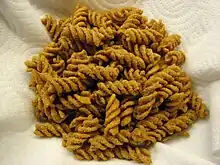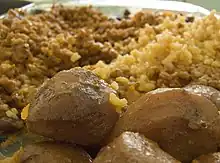The following is a list of Israeli dishes. For the cuisine, see Israeli cuisine (Hebrew: המטבח הישראלי).
Main dishes

Meat
- Jerusalem mixed grill—originating in Jerusalem,[1] a mixed grill of chicken hearts, spleens and liver mixed with bits of lamb cooked on a flat grill, seasoned with a spice blend and served with rice, mujaddara or bamia
- Kubba seleq—stew or soup made of beet
- Merguez—a spicy sausage originating in North Africa, mainly eaten grilled in Israel
- Moussaka—oven-baked layered ground-meat and eggplant casserole
- Schnitzel—fried chicken breast with breadcrumb or spice-flavored flour coating
- Shashlik—skewered and grilled cubes of meat
- Skewered goose liver—flavored with spices
Fish

Gefilte fish topped with slices of carrot
- Denesse—in the coastal region, baked with yogurt, tomatoes, garlic, dried mint and cucumbers; also prepared fried
- Gefilte fish—traditional Ashkenazi Jewish quenelles made of carp, whitefish, or pike, typically eaten as an appetizer
- Tilapia—St. Peter's fish, eaten in Israel and especially in Tiberias fried or baked with spices
Vegetarian

Ptitim
- Brik—thin pastry around a filling, commonly deep fried
- Burgul—wheat, cooked in many ways
- Hamin—long-cooked Shabbat stews made with a variety of meats, grains and root vegetables
- Jakhnun—pastry served on Shabbat morning with fresh grated tomato and skhug, eaten for breakfast especially on Shabbat
- Khachapuri—bread filled with eggs and cheese
- Kishka—stuffed derma, typically cooked in Shabbat stews
- Ktzitzot Khubeza—a patty made of mallow, bulgur/bread crumbs, eggs, onion, olive oil
- Kubba bamia—dumplings made of semolina or rice and okra cooked in a tomato stew or soup
- Macaroni Hamin—a traditional Sephardic Jerusalemite dish, originally from the Jewish Quarter of the Old City of Jerusalem
- Malawach—bread eaten with fresh grated tomato and skhug
- Orez Shu'it—white beans cooked in a tomato stew and served on rice
- Ptitim—toasted pasta shaped like rice grains[2]
- Ziva—puff pastry topped with sesame seeds and filled with cheese and olives
Soups

Soup with matzah balls
- Maraq 'Adashim—lentil soup cooked with tomato sauce
- Maraq Shuit—white-bean soup cooked with tomato sauce
- Matzah ball—dropped into a pot of salted boiling water or chicken soup, a staple food on Passover.
- Shkedei marak—small yellow squares made from flour and palm oil.
Meze
.jpg.webp)
Bourekas served with Israeli salad, olives and feta cheese
- Bourekas—phyllo or puff pastry filled with vegetables, cheese, meat, spices, herbs, nuts, pickles, etc. (comes from börek)
- Kreplach—small dumplings filled with ground meat, mashed potatoes or another filling, usually boiled and served in chicken soup, though they may also be served fried.
Salads and dips

Salat ḥatzilim b'mayonnaise
- Cabbage salad
- Carrot salad
- Coleslaw
- Greek salad
- Hamusim—vegetables pickled in a pot, such as cucumber and cabbage, eggplant, carrot, turnip, radish, onion, caper, lemon, olives, cauliflower, tomatoes, chili, bell pepper, garlic and beans
- Israeli salad—made with tomatoes, cucumbers, onions, parsley
- Matbucha—cooked dish of tomatoes and roasted bell peppers seasoned with garlic and chili pepper
- Salat avocado—rural salad made of avocados, with lemon juice and chopped scallions
- Salat ḥatzilim b'mayonnaise—contains fried eggplant, mayonnaise, garlic
- Sabich salad—rural salad dish, the ingredients are almost the same as in sabich itself without the hummus and pita bread
Cheeses and yogurts

Safed cheese (Tzfat)
- Cottage cheese
- Circassian cheese—a mild cheese that does not melt when baked or fried, and can be crumbled
- Feta cheese
- Gvina levana—Israeli quark cheese, sold in different fat content variations (1-2%, 3%, 5% and 9%)
- Milky—yogurt with chocolate pudding, vanilla whipped-cream and other variations
- Sirene—a type of brined cheese made in the Balkans
- Tzfat cheese—semi-hard salty sheep milk cheese
Spices and condiments
- Ras el hanout—used in many savory dishes, sometimes rubbed on meat or fish, or stirred into couscous, pasta or rice
- Sumac—dried fruits are ground to produce a tangy, crimson spice
- Hawaij—a variety of Yemeni ground spice mixtures
- Filfel chuma—a chili-garlic paste similar to a hot sauce originating from Libyan Jews
- Skhug—the hot sauce of choice in the Middle East, made from chili peppers, cilantro, and various spices, red or green, depending on the color of the chilis
- Amba—tangy mango pickle condiment of Iraqi-Jewish and Kurdish-Jewish origin
Breads
Breads
.jpg.webp)
- Bagel—a ring of yeasted wheat dough, roughly hand-sized, first boiled for a short time in water and then baked
- Challah—a special bread of Eastern-European origin in Ashkenazi Jewish cuisine, usually braided
- Kubaneh—traditional Yemenite Jewish bread similar to monkey bread
- Malawach—thin layers of puff pastry brushed with oil or fat and cooked flat in a frying pan
- Matzah—an unleavened flatbread
- Mofletta—a thin crêpe made from water, flour and oil
- Sliced bread—less common today
Bread dishes
- Bagel toast
- Falafel in pita–Israeli pita stuffed with falafel balls and Israeli salad[3]
- Havita b'laffa—omelette in taboon bread, served with hummus or labneh
- Jerusalem mixed grill—can be served in pita or laffa
- Lahmacun—round, thin piece of dough topped with minced meat (most commonly beef and lamb) and minced vegetables and herbs including onions, tomatoes and parsley, then baked
- Sabich—served in pita, traditionally containing fried eggplant, hard-boiled eggs, hummus, tahini, Israeli salad, potato, parsley and amba. Traditionally it is made with haminados eggs. Sometimes it is doused with hot sauce and sprinkled with minced onion
- Tunisian sandwich—warm sandwich with tuna, hard-boiled egg, potato, harissa and olives
Snacks

Grill-flavored Bissli

An Israeli wafer
- Bamba—a peanut-butter-flavored snack
- Bissli—popular flavors are "Grill" and "Barbecue", others include onion, smoky, pizza, falafel, Mexican, and hamburger
- Bourekas—a popular baked pastry
- Cow Chocolate—a brand of chocolate products
- Wafer
- Frikandel—a sort of minced-meat hot dog
- Klik—various chocolate, candy, and chocolate-covered products, including chocolate-covered corn flakes and malted milk balls
- Krembo—a chocolate-coated marshmallow treat
- Mekupelet—a bar of thinly folded milk chocolate
- Pannekoek special—pancake or crêpe filled with Nutella chocolate spread and banana
- Pesek Zman—brand of chocolate bar
- Sufganiyah—a round jelly doughnut
- Sfenj—a light, spongy ring of dough fried in oil, eaten plain, sprinkled with sugar, or soaked in honey
- Tortit—a wafer coated with chocolate containing rum-like almond cream
Sweets and desserts

Rugelach
- Fazuelos—Sephardic pastries of thin fried dough
- Hamantash—an Ashkenazi triangular filled-pocket cookie
- Ice cream—ice creams, ice pops, and sorbets come in many flavors including halva, hummus, Bamba, arak, watermelon, sirene, labane, and za'atar
- Cheesecake—are very popular in Israel , especially during Shavuot when it is customary to eat dairy foods.
- Crumb cake—is a cake made of yeast dough covered with a sweet crumb.
- Krantz cake—variations include one filled with chocolate and raspberry jam, another soaked in honey syrup
- Kugel—a baked pudding or casserole, most commonly made from egg noodles
- Lahoh—a spongy, pancake-like bread originating from Somalia and the Horn of Africa
- Lekach—a honey-sweetened cake
- Levivot—Hanukah latkes (potato pancakes)
- Pannekoek special—pancake or crêpe filled with Nutella chocolate spread and banana
- Rugelach—a triangle of dough around a filling
- Silan—date honey
- Watermelon with sirene or safed cheese, and sometimes mint leaves
Beverages

Limonana
- Apricot juice
- Arak—Anise-flavored alcoholic beverage, sometimes flavored with grapefruit or khat juices instead of water
- Beer
- Gat—A juice made of khat, in Jerusalem it is mixed with citron and named Etrogat
- Limonana—type of lemonade made from freshly-squeezed lemon juice and mint leaves
- Orange juice
- Pomegranate juice
- Pomegranate wine
- Shoko Bsakit—chocolate milk in a bag
- Sugarcane juice
- Tea—sometimes flavored with rosewater, mint, lemon juice, honey or date honey
- Turkish coffee
- Vodka—distilled beverage composed primarily of water and ethanol, sometimes with traces of impurities and flavorings
- Wine
Other
Starch
See also
References
- ↑ Ottolenghi, Y.; Tamimi, S. (2012). Jerusalem: A Cookbook. Potter/TenSpeed/Harmony. p. 326. ISBN 978-1-60774-395-8. Retrieved May 4, 2017.
- ↑ Gaunt, Doram (May 9, 2008). "Ben-Gurion's rice". Haaretz. Retrieved 19 August 2014.
- ↑ "A Brief History of Falafel in Israel".
This article is issued from Wikipedia. The text is licensed under Creative Commons - Attribution - Sharealike. Additional terms may apply for the media files.




